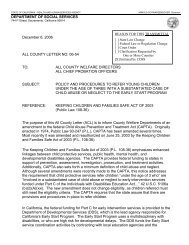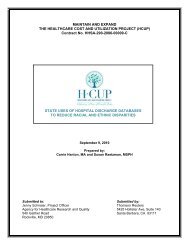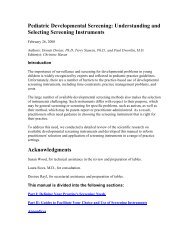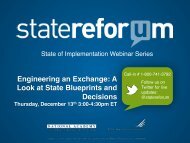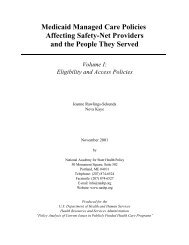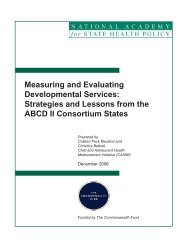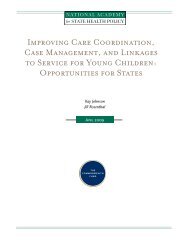Developing Federally Qualified Health Centers into Community ...
Developing Federally Qualified Health Centers into Community ...
Developing Federally Qualified Health Centers into Community ...
Create successful ePaper yourself
Turn your PDF publications into a flip-book with our unique Google optimized e-Paper software.
ADDITIONAL POLICY OPTIONS TO PROMOTE COMMUNITY NETWORKS<br />
Our interviews with stakeholders identified a number of federal and state policies that<br />
could be improved or developed to provide further incentives to develop community<br />
networks led by FQHCs.<br />
• Although Medicare productivity requirements are being discontinued under the<br />
Affordable Care Act, a 2005 Government Accountability Office report found that<br />
seven states limit reimbursement for reasonable costs by setting performance or<br />
productivity standards. These states stipulate the number of visits per year that a fulltime-equivalent<br />
physician should provide and use similar guidelines for other<br />
practitioners. Most of the states using performance or productivity standards relied on<br />
the guidelines specified by Medicare. 38 FQHCs and Primary Care Associations<br />
complain that such requirements constrain an FQHC’s ability to innovate. If providers<br />
are being asked see patients too quickly, there is little time for innovations that<br />
require Plan, Do, Study, Act approaches. Less emphasis on visit-based productivity<br />
requirements is needed, particularly when FQHCs participate in innovative models<br />
of care.<br />
• A higher federal matching rate is needed for certain Medicaid services, now deemed<br />
administrative, that help states sustain a network infrastructure. For instance, the<br />
infrastructure that is needed to track clinical measures is currently paid for at the<br />
lower administrative rate. CMS could consider providing a higher rate to help states<br />
develop the infrastructure needed to manage community networks.<br />
• Many private providers do not understand the federal requirements surrounding<br />
FQHCs. On the other hand, many FQHCs do not appreciate the extraordinary<br />
demands placed on high-volume Medicaid private providers. This lack of understanding<br />
may impede collaborative relationships. Opportunities to help FQHCs and private<br />
providers build trust and improve collaboration might help bridge this divide.<br />
• Primary Care Associations or FQHC networks might serve as facilitators for<br />
developing collaborations and sharing best practices across sites within a state.<br />
Conceivably, a Primary Care Association or FQHC network might even serve as the<br />
community hub itself, perhaps offering data analysis and support to practices.<br />
Opportunities are needed to convene FQHCs, Primary Care Associations, FQHC<br />
networks, and federal and state policymakers to collaborate on solutions to improve<br />
the primary care delivery system.<br />
30



